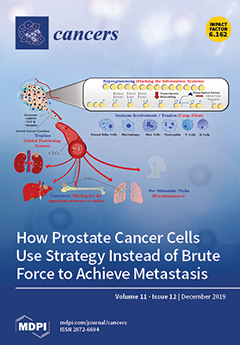MET exon 14 (
METex14) skipping mutations are an emerging potentially targetable oncogenic driver mutation in non-small-cell lung cancer (NSCLC). The imaging features and patterns of metastasis of NSCLC with primary
METex14 skipping mutations (
METex14-mutated NSCLC) are not well
[...] Read more.
MET exon 14 (
METex14) skipping mutations are an emerging potentially targetable oncogenic driver mutation in non-small-cell lung cancer (NSCLC). The imaging features and patterns of metastasis of NSCLC with primary
METex14 skipping mutations (
METex14-mutated NSCLC) are not well described. Our goal was to determine the clinicopathologic and imaging features that may suggest the presence of
METex14 skipping mutations in NSCLC. This IRB-approved retrospective study included NSCLC patients with primary
METex14 skipping mutations and pre-treatment imaging data between January 2013 and December 2018. The clinicopathologic characteristics were extracted from electronic medical records. The imaging features of the primary tumor and metastases were analyzed by two thoracic radiologists. In total, 84 patients with
METex14-mutated NSCLC (mean age = 71.4 ± 10 years; F = 52, 61.9%, M = 32, 38.1%; smokers = 47, 56.0%, nonsmokers = 37, 44.0%) were included in the study. Most tumors were adenocarcinoma (72; 85.7%) and presented as masses (53/84; 63.1%) that were peripheral in location (62/84; 73.8%). More than one in five cancers were multifocal (19/84; 22.6%). Most patients with metastatic disease had only extrathoracic metastases (23/34; 67.6%). Fewer patients had both extrathoracic and intrathoracic metastases (10/34; 29.4%), and one patient had only intrathoracic metastases (1/34, 2.9%). The most common metastatic sites were the bones (14/34; 41.2%), the brain (7/34; 20.6%), and the adrenal glands (7/34; 20.6%). Four of the 34 patients (11.8%) had metastases only at a single site.
METex14-mutated NSCLC has distinct clinicopathologic and radiologic features.
Full article


